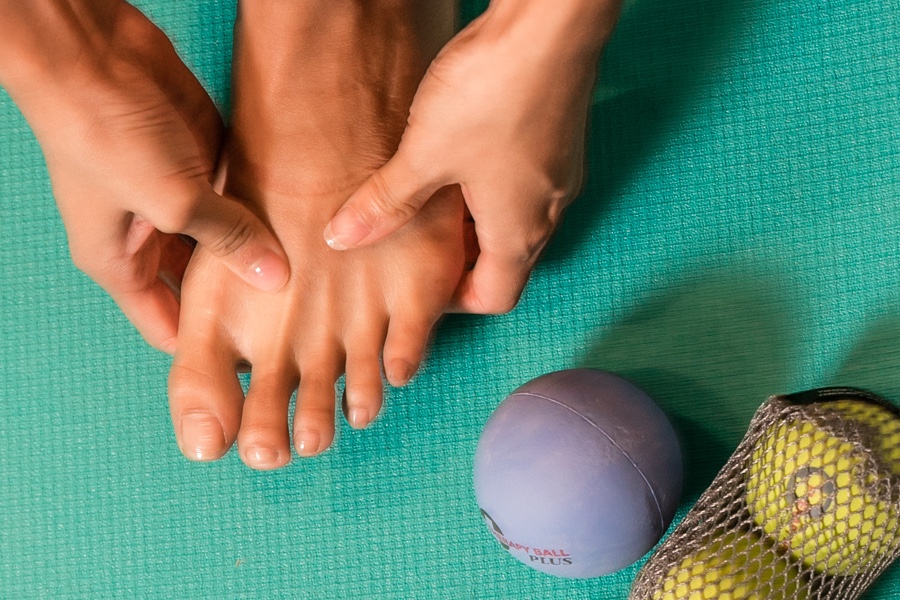
A central tenet of the Tune Up Fitness approach to reaching peak physical condition is finding and illuminating “body blind spots”. These are areas of the body that have been “overused, underused, misused, abused, or totally confused.”
When your body is riddled with blind spots, you shortchange your ability to access and engage all the muscle fibers–all possible “movers”–in any given activity.
Think about it, if you’re trying to PR in a deadlift, but you can only fire 80% of available muscle fibers, do you think your strength will be at its max? Of course not.
It’s normal to focus on the biggest, most famous muscles in any given physical challenge: the pecs, the lats, the abs, the quads, the glutes, etc. It’s easy to always prioritize those big players in high performance.
But doing so might shortchange the cumulative power of the more petite players in any given movement. In particular, the small movers of your fingers and toes which are on distal (far from trunk of the body) ends of your limbs.
Because they seem far away from the big movers, your fingers and toes can get forgotten. But learning to strengthen your hands and feet will give you an extra edge on the competition–even if “the competition” is you, last week.
Why Finger and Toe Exercises Are Important for Peak Performance
Training Small Movers Wards off Overuse Injuries
Overuse is essentially “using one muscle group more than another” (The Roll Model Method, p. 33). The issue with overuse while training is that it can lead to inflammation, injury and breakdown of that body part.
Overuse can set your training back significantly by causing an injury that might take weeks or months to heal… and then never quite be “good as new” again. This can be prevented by training not just hard, but smart.
To help prevent overuse, teach your body to access more of its available contractile tissues for any given movement. For many, these are the oft-ignored small movers of the hands, feet, fingers and toes.
How to Wake Up the Small Movers of Your Hands and Feet
It might be necessary to quite literally “wake up” these small movers, because it’s possible they’ve been very, very sleepy for quite some time. In fitness terms, this is called underuse.
Underused muscles are “perpetually ignored by movement habits, whether in daily life or in your expression of fitness. They are often bypassed or overlooked due to an old injury, lack of training, a lack of sensing, or failure to realize that these tissues are needed for proper mechanics.” (The Roll Model Method, p. 33)
The best way to wake them up is to use them more consciously. Start by building proprioception of these tissues through rolling them out on therapy balls.
“Proprioception is your body’s sense of itself; your inner GPS system. The ability to sense the position, location, orientation, and movement of your body and its parts.”*
Proprioceptors a type of mechanoreceptor in your tissue. They’re nerve endings that send information back to your central nervous system. Regularly rubbing your hands and feet with the grippy rubber surface of the Roll Model therapy balls will strengthen this mind/foot/hand connection and give you more access to your small movers.
“It’s actually quite easy to heighten your body’s sense of itself using the Roll Model Method. Your body is a festival of nerve endings longing for stimuli and novelty. The balls give them just the right kind of rub to help your tissues get a better sense of themselves.” (The Roll Model Method, p. 112)
“Your discipline in regularly stimulating your tissues will make your nerve conductivity more accurate and help the nerves themselves maintain balance and function.” (The Roll Model Method, p. 112)
Refining the Use of Your Fingers and Toes
After “waking up” the proprioceptors in your hands, feet, fingers and toes, it’s time to put them to work. Ask the muscles to do more than swipe a smartphone or stay stuffed in a shoe. Design exercises that get these small movers to articulate their own unique ranges of motion.
Here’s one way you can reclaim range of motion in your metatarsals…
Loop a strap around your big toe (first metatarsal), take hold of your pinky toe (fifth metatarsal) and gently pull them in opposite directions. Then practice “toe spreading” without the props to build coordination and strength.
Next, go even further by switching some of your training drills to barefoot.
Muy Thai/Kickboxing competitor Jon “Big Red” Christenson opts for barefoot kettlebell training on many different surfaces and in all kinds of environments…
“I love to be barefoot, if I could I’d go to work barefoot… I’d do absolutely everything that I can. Everyone thought I was weird at first, but I was like I want to be able to feel the ground… martial arts helped because we train barefoot. Newbies complain that mats are so uncomfortable [under their feet]. But sometimes when you’re in back preparing for a fight, you’re in kitchen, you’re on cement, you have to get used to it.”
The same goes for hands and fingers. After prepping them with self massage, find ways to get them to work pulling their weight in all different directions of motion.
By including specific training for your small movers, they will be primed and ready to go when you take on bigger, more challenging physical feats.
Your ankles, soles and toes will be there for you; stabilizing your balance and assisting with running, jumping, kicking and pivoting.
Your wrists, palms and fingers will be dialed up to grip a football, pack a punch, hold a handstand or swing a kettlebell.
The bigger movers that are closer to the trunk will get a boost of power as these small movers step up and play their parts. And better still, you will feel even more embodied–you will have set up residence in more of your tissues, giving you even more opportunities to play harder, bigger and better.
*Jaap C. van der Wal, “Proprioception, mechanoreception and the anatomy of fascia,” in Fascia: The Tensional Network of the Human Body (Elsevier, 2012: 81)
Author: Ariel Kiley
Related Article: Training for a Big Move: Back Stability, Grip Strength and Beyond (Videos)
Learn more about our Therapy Ball Products and Programs
Interested in video and blog content targeted to your interests?

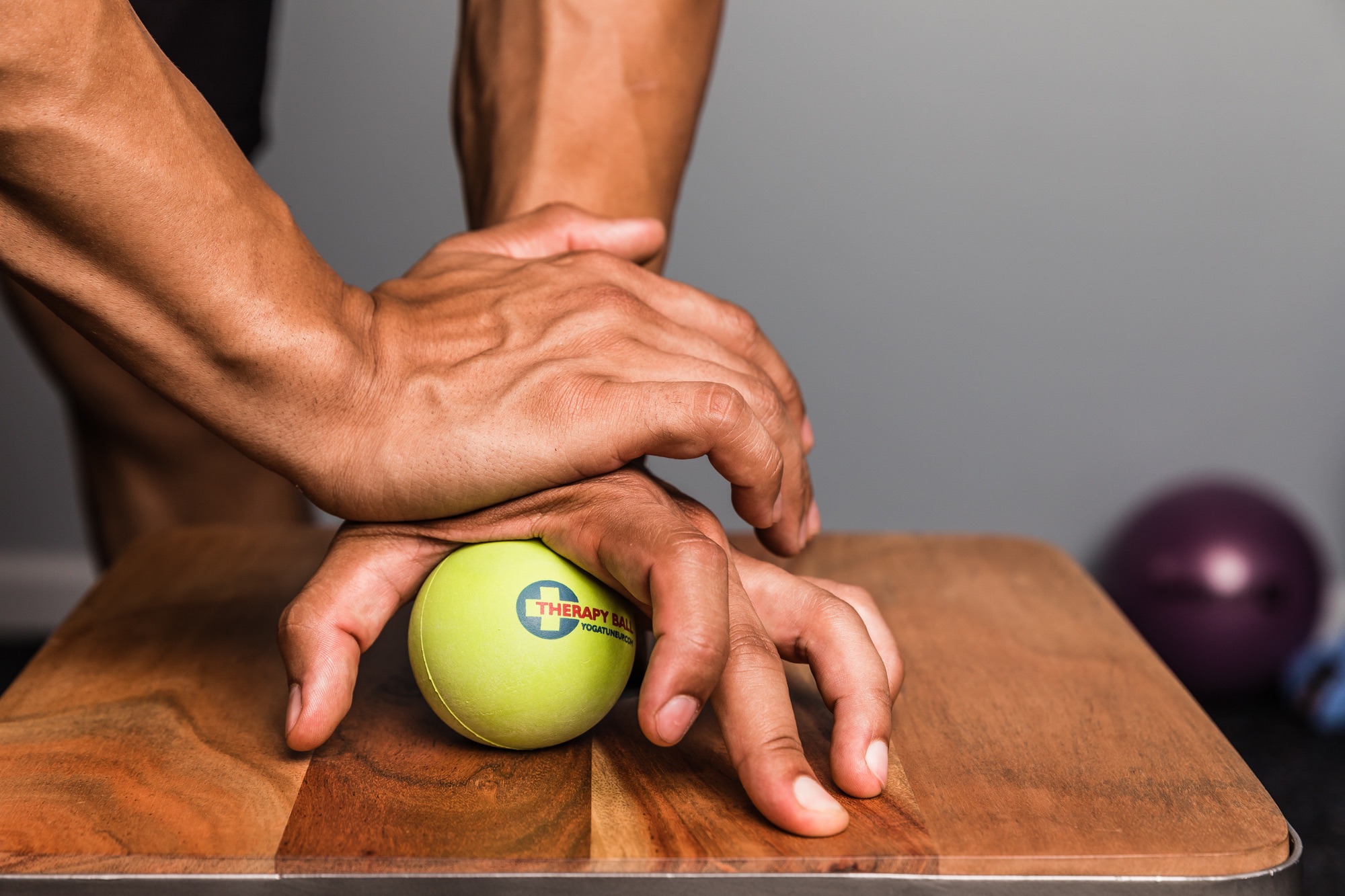
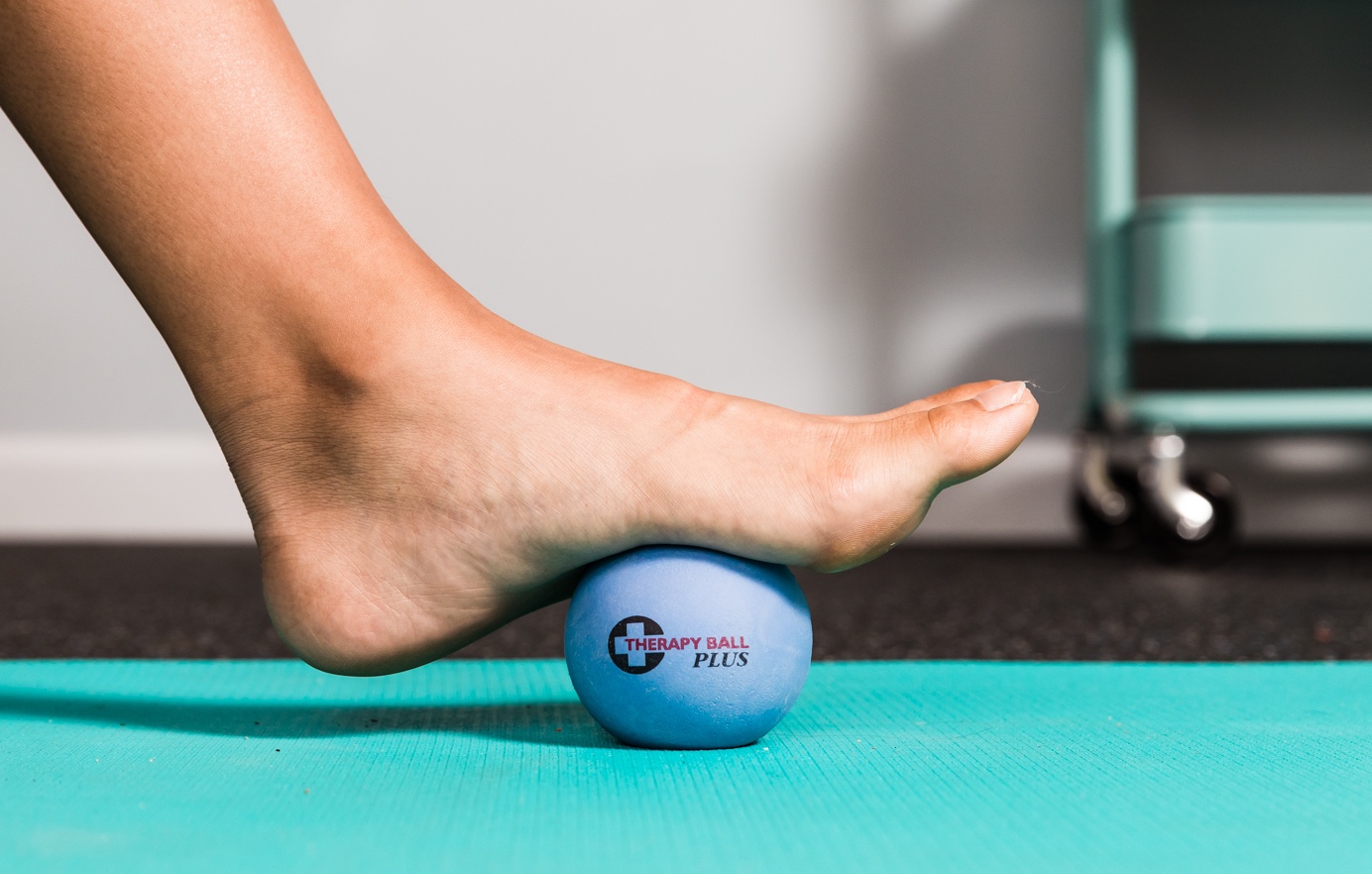
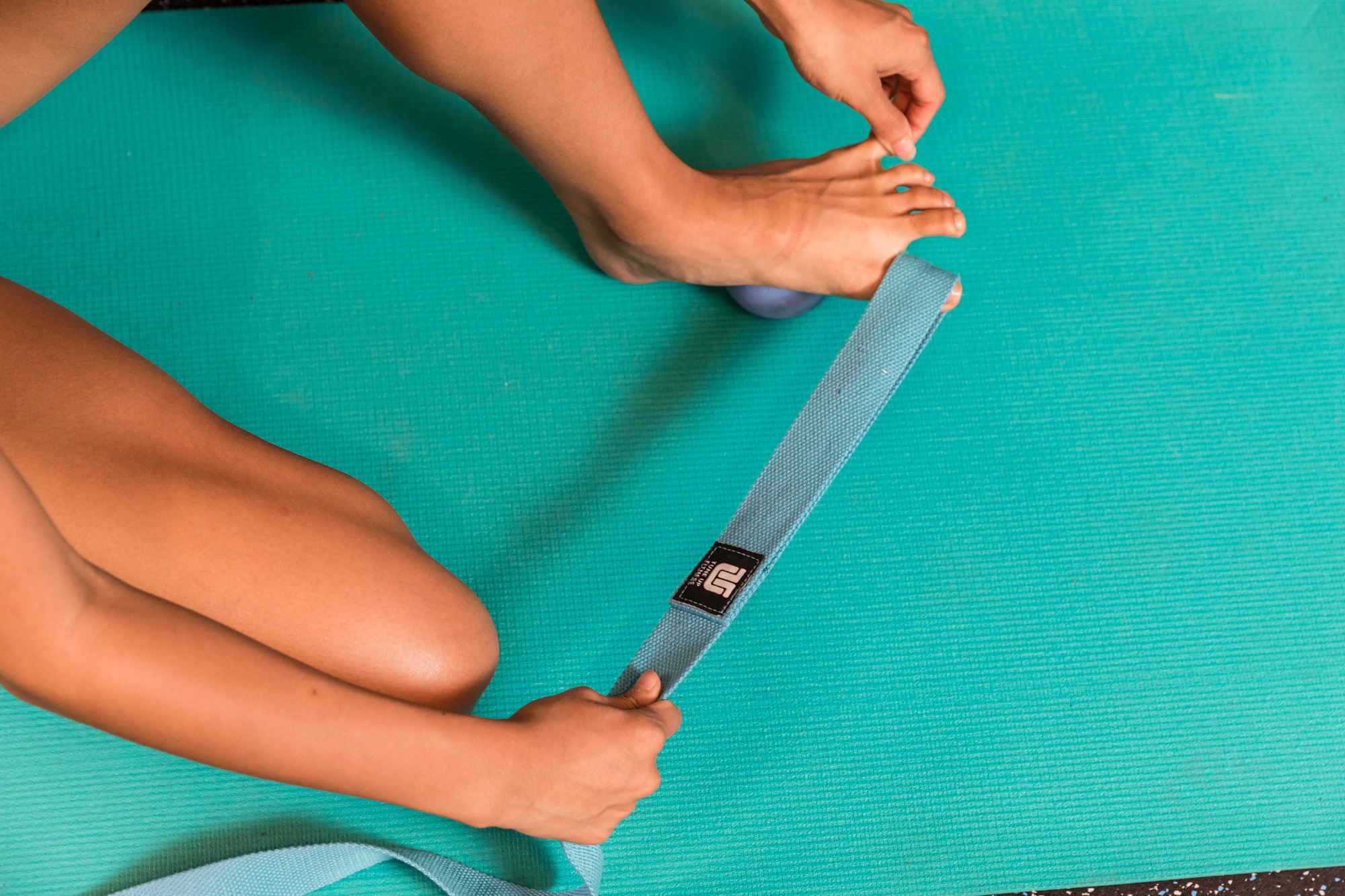
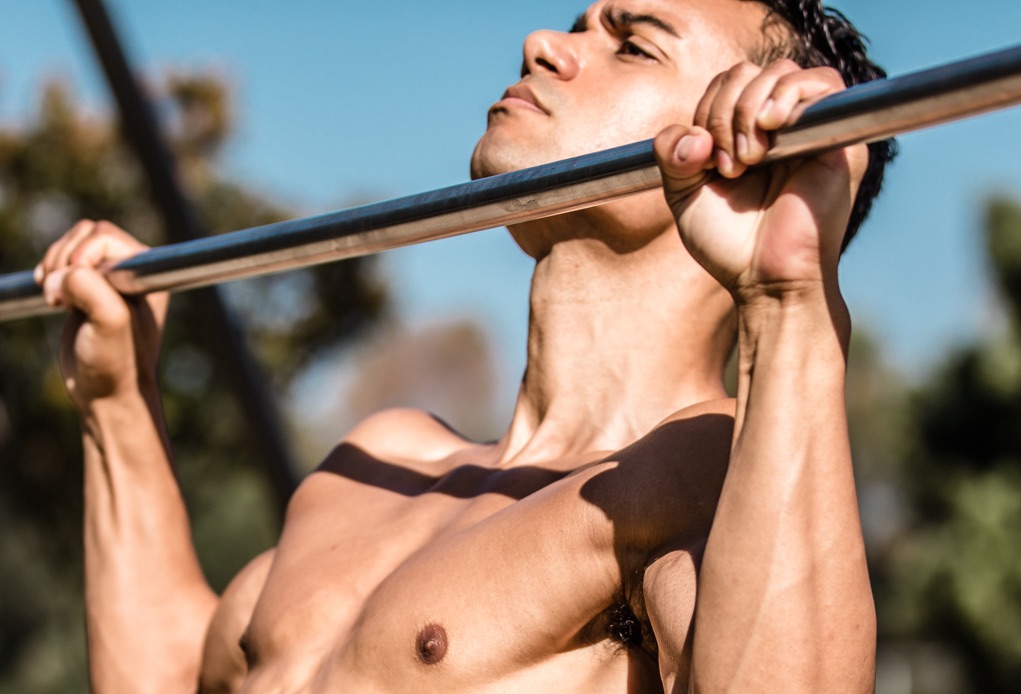











I love the explanation of proprioception being the GPS of the body! That’s such an easy way of describing it. Also being an crocheter for many years I roll my forearms, hands and shoulders regularly but strengthening my hands needs to be the next priority.
“Your body is a festival of nerve endings longing for stimuli and novelty,” it frames it as your responsibility as the “body owner” to engage with it! Even more so to not forget the smaller parts and how important working with/waking up our fingers and toes can help us to achieve our fitness goals. As a former gymnast, they were critical to keeping me on the balance beam and catching the bar- but 20 years later it is time to bring them back into my movement practice!
I feel like I am guilty of ignoring my fingers and toes in my own rolling practice, yet I do place a significant amount of stress on these “small movers” as they are referred to in this article. It is nice to think about just gentle roll outs for these areas can make a big difference. I appreciate the quote about propioception being the body’s GPS system. Point taken that rolling is so much more than simply rolling out the knots!
What a great post! As I am an aging, I am paying extra attention my hands and feet. I walk barefoot whenever and wherever. My personal trainer brings me my weights and would put them away but I always say that I need to put them away to work on my grip strength. Thanks for this reminder and the examples you provided.
Why do we take our feet and hands for granted? It’s pretty common to just use them every day without taking special care for them in a proper way. Would we do anything like that to our car? No, it gets washed, maintained, fresh gas and oil changes… This article is a wonderful educational call for selfcare and body awareness.
I absolutely cherish how hands and feet get the attention they deserve in YTU. Coming from a dance background with overuse injuries in my big toe, I have for many years done lots of toe and foot exercises but truly NOTHING (and there has been a lot) has given me the relief that combining Roll Model rollouts with YTU foot exercises has. Patient, present practice here has resulted in relief that has brought tears to my eyes at times – highlighting a) how truly impactful even small areas of the body can be (for better or worse) and b) how well this system found me right where I was (in pain and frustrated) and helped me move toward inquiry, connection and ultimately, restoration in a small but significant way. In my case, I needed to find just the right door into my big toe and wow do I appreciate YTU helping me find it.
No doubt that the hands/wrist and feet/ankles will seem the least important body areas in a fitness workout. As mentioned in the article, they are not the fancy and flashy big muscles that want to be flexed and displayed. Nonetheless, if attention is given to the care and maintenance of these important joints, this might become the crucial component to set you up for improvement and sustainability in your training. I would like to see some of the big bodybuilders i know get down and roll out their feet, ankles, calves and shines before their weight training… rolling will blow their minds and prevent them from blowing out their joints 😅
Thank you for talking about embodiment and slowing down to actually feel the little movers, and that they’re just as important as the big movers! I forget that blindspots aren’t just where I’m lacking, rather where I have over extended myself as well.
It’s so crazy that we stand on these tiny little things all day and put them through so much stress. No wonder there are so many bones because our feet do so many things!!! I totally get the “wake up” aspect of this work. You basically have to remind your brain that your feet exist. I’m really excited to use the strap in new ways!
I really appreciated this article and the highlighting of the little muscle groups in the body we over use and misuse. Especially the feet! we rely on our entire body every day, but our feet take so much of our load and rarely get appreciated or noticed. I only recently started paying more attention to my feet and that is because i started noticing pain in my first metatarsal on my left foot. I unfortunately waited too long to do anything about it and now have bone spurs affecting the space between my hallucis and first metatarsal. Thank goodness for rolling!
Hands and feet are so often overlooked and under-loved! After a recent wrist injury, I had to re-map my hand that had become a body blind spot after several weeks of little to no movement or use. It never ceases to be amazing how effective just a few minutes of rolling and deliberate articulation can be to enhance proprioception and reduce pain!
This article reminds us of the importance of taking care of our feet and hands. These parts of the body are often used and especially neglected
Thanks for this article. I admit that it is easy to neglect our hands and our feet when they are the pillars of our daily life. It is important to take care of it to have better control, stability and mobility. Lucky that YTU balls have arrived in my life!
I will definitively use to toe spreading method to gain more range of motion in my toes.
I am working behind a desk most of the day. I will work barefoot from now on and start practicing all these exercices ! Merci !!!
I’ve been working with a movement coach for over 3 years now, and he’s impressed on me the importance of being barefoot – and, when not possible, minimalist shoes – to be able to feel the ground and work the feet more. When I first started this, my feet actually hurt, but they’ve adapted and gotten stronger. However, I need to work more with my feet, and the suggestions here are a great starting point – thanks!
What is so wonderful about reclaiming the “small movers” of the hands and feet is that they are so accessible to receive the therapy balls massage. For example when you take your break from typing on the computer, grab that ball and roll out that forearm then use the ball to strengthen your grip by giving it a big squeeze and release. Get creative, get rolling!
Brilliant! We spend so much time on the big stuff but ignore our feet, which feet our proprioception and orientation all the way up our body, and our hand, which do so much for us every day. I never put much thought into just how important this truly is until now. Thank you!
I am guilty of not making these small movers the big priority that they deserve to be! When I remember to roll out my feet before a workout, my balance and strength in single-leg exercises/poses are much improved. I’ll be adding this back into my daily routine as well as including some much-needed SMFR for my hands!
As the article mentions, in most yoga classes we focus on working the large muscles, either elongating or strengthening and we forget those small parts of the body that do not seem to contribute or be of significance to improve our practice as they are The feet and hands. The feet, for example, contain tiny bones that are the ones that move us from one side to the other and give us stability in the postures, especially for equilibrium postures. The hands are also very often forgotten and are the basis of the arms balance positions, the accommodation of them depends on stability and also the one that can hurt me or not.
I was interested in this article because I have an injury to my right wrist, and by not having strength I avoided for a long time doing the balance positions. And after several years of not even trying, I am giving myself the opportunity to do it again, but I must be kind to me because not all variations are appropriate and then my body compensates with the elbow and / with the shoulder, and then I have To stop practicing for up to weeks, I am in search of finding the balance of how far to go.
As the article mentions, in most yoga classes we focus on working the large muscles, either elongating or strengthening and we forget those small parts of the body that do not seem to contribute or be of significance to improve our practice as they are The feet and hands. The feet, for example, contain tiny bones that are the ones that move us from one side to the other and give us stability in the postures, especially for equilibrium postures. The hands are also very often forgotten and are the basis of the arms balance positions, the accommodation of them depends on stability and also the one that can hurt me or not.
I was interested in this article because I have an injury to my right wrist, and by not having strength I avoided for a long time doing the balance positions. And after several years of not even trying, I am giving myself the opportunity to do it again, but I must be kind to me because not all variations are appropriate and then my body compensates with the elbow and / with the shoulder, and then I have To stop practicing for up to weeks, I am in search of finding the balance of how far to go.
Wendy
I’ve become more interested in strengthening the “small movers” specifically the hands and fingers. I enjoy doing handstands, this will be a good exercise to roll the connective tissues in the hands and feet as well since we are always on them. I attended a workshop where we were doing exercises on our fingertips and it was very difficult. Are there strength exercises that you recommend for the fingers and wrists?
I tried the abducting my toes and I was not able to move my right big toe as much as on the left side. What could this mean?
Hand and feet are where I started using the YTU balls. Love this!
In many areas of life, small details make big differences. The small movers of the body, like fingers and toes, have great potential to help the bigger muscles and movers improve their functioning. Using the Tune Up balls restore proprioception in these areas will definitely provide a “wake up” to the rest of the kinetic chain.
The best part of a massage is having hands and feet worked on. Love that the Yoga Tune Up balls allow me to do this on my own. I sit at my desk and roll out both feet while I’m working – great way to some self-care in!
I love using the Yoga Tune Up balls on my feet! I can’t go a day without using them. They’ve helped my feet feel better for months and it’s become an essential in my selfcare routine. Now it’s time to add onto my fingers and hands!
It’s a good article to learn the importance of the fingers and toes. Thanks! I like that!
Very interesting. I knew that the feet have an important role, but I neglect my main ones. Thank you for the analogy of proprioception with GPS. It’s very clear now for me.
I first learned about foot mobility, or our underuse of it, in Katy Bowman’s paradigm shifting, Move Your DNA. Since then I have become increasingly interested in strengthening the intrinsic movers of my feet. I often roll my feet on Tune-up therapy balls. I tried the metatarsal stretch using a looped resistance band around my big toe and pulling my little toe in opposite directions. I feel the stretch. I long to be able to abduct my toes with active movement but I have noticed that this feels near impossible. So I keep searching for ways to wake up my sleepy underused toes and foot musculature.
Very true… we are all focused on the big muscle groups that use tend neglect the small ones and the ones farthest from our torso. But little did we know that those little ones actually give us more power, coordination and balance, if we strengthen them. I like to use the Tune Up Therapy Balls for accessing those hidden/forgotten areas of the body. Thanks for the great information.
Having good coordination in our bodies is very important. This is helpful information will remember my metatarsals.
Hands and feet are so underused as they are on the distal ends of our limbs. I have found it helps for my balancing poses during yoga practices if I warm them up a bit before. Thanks for sharing all the handy waking-up exercises for the small movers!
There is a direct relationship between the strength of you grip and your risk of falling as you age. I agree let all work those small muscles.
Love spending time at the beach for lots of barefoot time.. Running in the sand by the shore line in my bare feet is my favorite!
Reflexology is one of the best body treatments in Traditional Chinese Medicine. Unfortunately lots of people totally ignore feet and hands not realizing how important they are. Im glad Yoga Tune Up teaches us about these crucial Small Movers of Hands and Feet!
Grip strength and wrist/ankle mobility are so important in every day movement and something that I regularly hear students/people asking questions or complaining about. When it comes to teaching or cueing movement, there are benefits from working from the center outward and there are equally important awareness points that come from working from the outer extremities inward. Another great reminder to hone in on all the different aspects of our bodies and our movement, not just the main action.
SO true about treating the small movers to optimize the big movers. I have noticed this when I play a sport like basketball, my ankles are much stronger and more mobile since changing up a lot of my training to barefoot or a minimalist shoe. Feeling the ground is so important. Also find when I roll my feet with intention my whole posterior chain benefits. The fuzz is real! In addition to the feet, i found the more I played with kettlebells the more my hands and forearms would tighten up so rolling the palms of my hands and moving my fingers through extreme flexion and extension, my grip strength has improved and my capacity to grip something for long periods has improved. You hit the nail, appreciate the post
Feet and hands have got to be the most under-targeted areas! We need these so much. I am always seeking new variations to get in some mobility in these areas. Thanks for these!
This is a great article to remind us that hands, feet, fingers and toes need some love as well. I work on my feet and toes fairly regularly but I often forget about hands/fingers until they are sore or hurting. This is a good reminder to put the prehab work in on this area prior to any issues arriving. ~Thanks
First of all, wow! Such well structured and informative article. I love the way it was broken down. Simple exercises such as spreading my fingers and toes allows me to feel to different layers of connected tissues in my body! I am not one that’s born with a sharp proprioception (in the process of budiling those sensors) but when I close my eyes and try the hands and feet exercises I can feel so much! Love this <3 Thank you!
After I rolled my feet, my downward dog and chair poses were so much more accessible. I had greater range of motion. My sister is on the computer all day and I gave her a set of balls, she rolled her fingers and felt less tension. Thank you for this article
this is an invaluable article! i love it. i always feel better if i warm up with wrist and fingers exercises and roll my feet. this article gives me a big picture perspective and i will work this into my routine.
Feet are so often neglected, so I like to really focus on feet and toes for myself and my students, especially older people who can struggle with balance. Also, wearing ‘barefoot’ shoes has been such a game changer for me 😀
Thanks for bringing up the importance of working on the extremities. One point I’d like to emphasize is how much of the motor map of the brain is disproportionately dedicated to the hands, and somewhat the feet. (Look up homunculus man for more info here.) In fact, the brain gives more attention to the hands than the entire rest of the arms and legs combined. That means, we have arguably greater potential to improve athletic performance by working our end points (hands and feet) than our arms and legs. In my osteopathy practice, I find that direct ball work on the feet (I use “Foot Rubz” brand ball) often clears 75-90% of the tension in the calves and legs after only a few minutes of direct facial and bony release at the foot through static and dynamic slow intentional rolling and compression. For whatever reason, the importance of extremity work is recognized in martial arts, but seemingly ignored or downplayed in western athletic training.
Our poor neglected hands and feet! The description is spot on: fingers only being used to jab and swipe at our smartphones, and feet stuffed into shoes and mostly immobilized. Use ’em or lose ’em. Thanks for the helpful tips and exercises to awaken these dormant little tissues.
The hands and feet are so often overlooked, I do give my feet a good amount of attention with the yoga tune up balls, and I work the articulation of my toes, but my hands could definitely use some attention as well. My sister always has hand cramps after knitting all day, Im excited to share this information with her as well!
I am always shocked by how weak my fingers and toes are when I have to grip at something. I have read headlines of articles and have seen on social media this obsession with articulating the hands and feet and I never knew why and this article totally changed that. I love the information about proprioception and the mind/hand/foot connection. Reading this article has put foot/hand health/strength/mobility at the forefronts of my interests and I look forward to becoming more aware of all of my “small movers”.
Thank you for this, it’s perfect timing! Will be putting your advice to good use when my cast comes off in the next week or two for a fractured fifth metatarsal.
Great article. thanks for sharing.